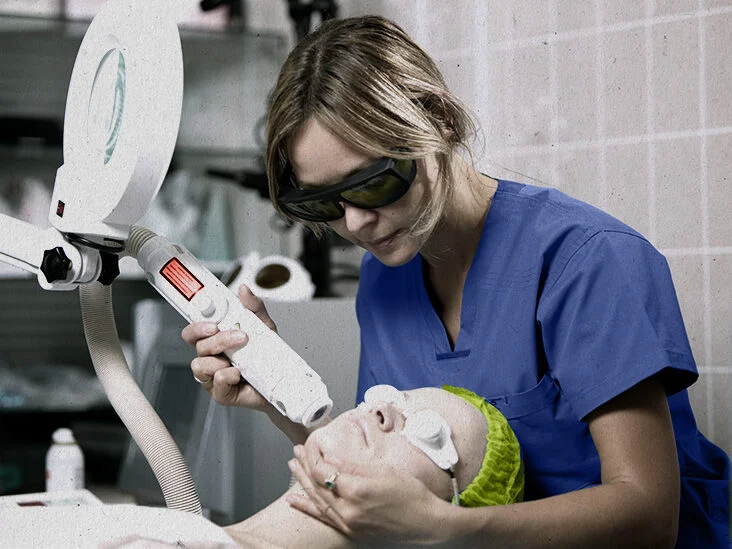Laser skin resurfacing has become increasingly popular as a non-invasive cosmetic procedure aimed at rejuvenating the skin and reducing the signs of aging. The procedure involves using a laser to remove layers of damaged or dead skin cells, revealing smoother, younger-looking skin underneath. While the benefits of laser skin resurfacing are numerous, it is important to understand that like any medical procedure there are risks involved that must be carefully evaluated before deciding if it is right for you.
In this article, we will explore the benefits and risks associated with laser hair removal or skin resurfacing. We will discuss how the procedure works, what types of lasers are used, and what results you can expect.
What is Laser Skin Resurfacing?
Laser skin resurfacing is a cosmetic procedure that uses laser technology to improve the appearance of the skin. The laser removes the outer layer of skin, which stimulates new collagen production and helps reduce fine lines, wrinkles, age spots, acne scars, and other imperfections. There are two types of lasers used in this procedure: ablative and non-ablative.
Ablative lasers use high energy beams to remove layers of damaged skin. This type of laser resurfacing provides more dramatic results but also comes with greater risks such as prolonged downtime and increased risk for infection or scarring. Non-ablative lasers use lower energy beams to stimulate collagen growth without removing the outer layer of skin. This type of resurfacing has less downtime but may require multiple treatments for optimal results.
Benefits:
Laser skin resurfacing is a cosmetic procedure that has gained immense popularity over the years, and for good reasons. The treatment utilizes laser technology to remove damaged skin layers, revealing smoother, younger-looking skin underneath. One of the primary benefits of laser skin resurfacing is that it effectively reduces the appearance of wrinkles, fine lines and age spots. This makes it a popular choice among individuals seeking to restore a youthful appearance.
Another benefit of laser skin resurfacing is that it can improve the texture and tone of your skin. Laser treatment stimulates collagen production in your body, which helps to tighten loose or sagging skin. Furthermore, laser therapy can also help reduce scarring caused by acne or injury. One added advantage of laser treatments is its precision- lasers are highly targeted and precise devices that allow dermatologists to specifically target problem areas on your skin without causing any damage to surrounding tissues or cells.
Procedure:
Laser skin resurfacing is a cosmetic procedure that involves the use of a laser to remove the outer layer of skin, revealing smoother and younger-looking skin underneath. There are several benefits to this procedure, including the reduction of fine lines and wrinkles, as well as the improvement of acne scars and other types of scarring. Additionally, laser skin resurfacing can help to reduce hyperpigmentation and age spots.
While there are many benefits associated with laser skin resurfacing, it is important to note that there are also risks involved with this procedure. Some potential risks include infection, scarring, and changes in pigmentation. It is important for individuals considering this procedure to discuss these risks with their doctor before undergoing treatment.
Potential side effects
Potential side effects of laser skin resurfacing include redness, swelling, and pain. These symptoms typically subside within a few days to a week post-procedure. Other common side effects may include itching, dryness, and peeling as the skin heals and regenerates. In rare cases, patients may experience more severe side effects such as infection or scarring.
It is important for patients to follow all post-care instructions provided by their healthcare provider in order to minimize the risk of complications. Additionally, patients with certain medical conditions or skin types may not be good candidates for laser skin resurfacing. Consultation with a qualified healthcare professional prior to undergoing the procedure can help ensure that potential risks are properly evaluated and addressed before proceeding.
Recovery:
Recovery is an important aspect to consider when undergoing laser skin resurfacing. Immediately after the procedure, patients may experience redness, swelling, and sensitivity in the treated area. It is normal for the skin to feel tight and dry as it heals. Patients should avoid direct sun exposure and use sunscreen with a high SPF to protect their sensitive skin during recovery.
It is recommended that patients take time off work or school to allow for proper healing. Depending on the depth of treatment, recovery can take anywhere from a few days to several weeks. During this time, it is important for follow cleveland facial as they provide services for patients to follow their doctor’s instructions carefully and avoid picking at any scabs or peeling skin. While laser skin resurfacing does come with some risks and potential side effects, following proper post-procedure care can greatly reduce these risks and lead to successful results. Recovery plays a crucial role in achieving optimal outcomes from this cosmetic procedure.
Conclusion:
In conclusion, laser skin resurfacing can provide numerous benefits to individuals looking to improve the appearance and texture of their skin. From reducing wrinkles and pigmentation to minimizing scars and acne, this procedure has shown promising results for many patients. However, it is important to consider the potential risks involved, such as scarring or changes in skin color. Therefore, it is crucial to consult with a qualified and experienced medical professional before undergoing laser skin resurfacing. Ultimately, with the right precautions taken and proper care post-treatment, this procedure can be a game-changer for those seeking smoother, clearer skin.

